N.B. COVID-19 roundup: 2 more deaths, circuit breaker expands across Zone 2
Much of Saint John region under 2-week circuit breaker, existing circuit breaker extended for at least 7 days
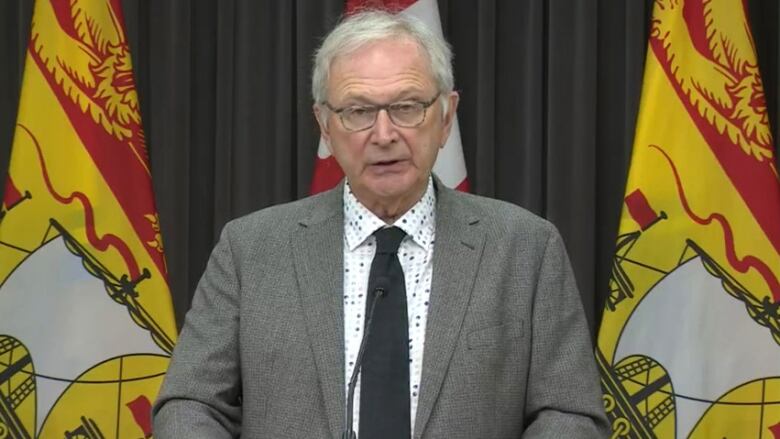
A large section of the Saint John region, Zone 2, will be under a two-week COVID-19 circuit breaker, starting Friday at 6 p.m., due to Public Health concerns over the rising number of infections.
And a circuit breaker in Zones 1,3 and 4, which was scheduled to end Friday, will be extended for at least seven days, Premier Blaine Higgs announced.
The decision comes asNew Brunswick recorded two more COVID-related deaths Thursday and69 new cases of COVID.
Two people in their 80s one in the Moncton region, Zone 1, and the other in the Fredericton region, Zone 3have died as a result of COVID-19.
This pushes the death toll to 55 this month alone and 114 since the beginning of the pandemic.
"Despite this sad news, we are seeing hopeful signs that the fourth wave of the COVID-19 pandemic is beginning to recede,"Dr. Jennifer Russell, the province's chief medical officer of health, told the COVID briefing.
"The Public Health measures put in place earlier this month are working."
Since circuit breakers were implemented Oct. 8, new cases have decreased by 50 per cent and active casesby nearly a third, Russell said.
Without introducing these measures to restrict close contacts in COVID "hot zones," provincial modelling shows the number of hospitalizations would have "soaredto over 100 cases more than three times the current number."
Still, the health-care system remains "under strain," with 120 regional health authority employees offfor COVID-related reasons,and elective surgeries and other services suspended.
Public Health is also concernedabout the high number of COVID-19 transmissions in Zone 2, particularly in Saint John and the surrounding areas, Russell said.It has the highest positivity rate in the province.
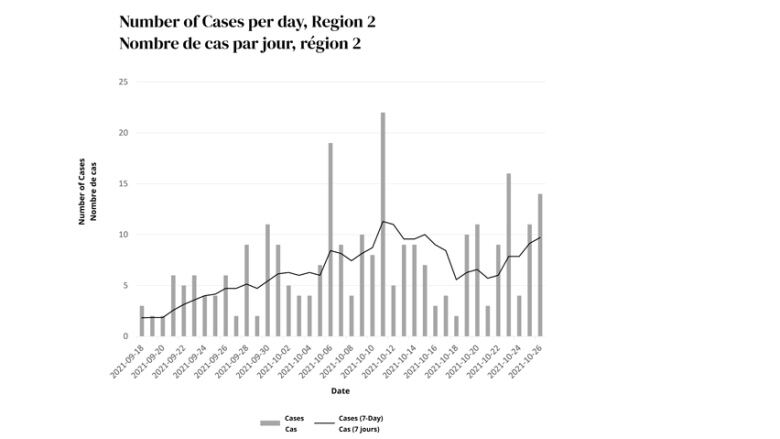
As a result, Higgsannounced the circuit breaker,which already included Havelock in Zone 2, will now also coverNew RiverBeach andLepreau to the west of the zone, north to the communities of Clarendon and Welsford, east to the community of Head of Millstream and including all communities in Saint John and Kings counties.
The areas affected by the one-week extension includeZone 1,Moncton region,as far north as and including Sainte-Anne-de-Kent; the northern portion of Zone 3 from and including Deerville and Florenceville-Bristol, but excluding Hayesville and Parker Ridge, as well as all of Zone 4, theEdmundston region.
The Campbellton region, Zone 5, is also under a circuit breaker, scheduled to end next Friday.
The expanded and extended circuit breakers "may feel like a setback," Higgssaid, but it's a "cautionary move" toensure cases and hospitalizations "don't get away from us."
"We have done well getting control of this outbreak. Now is not the time to ease our efforts."
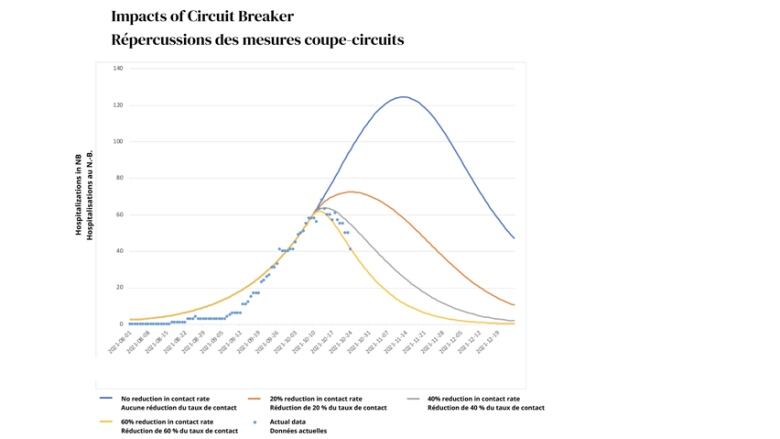
People who live in circuit breakerareas must not have gatherings at private homes inside or outside with anyone who does not live at that home, with a few exceptions.
A single household can be extended to include "caregivers for any of those people, plus any parent, child, sibling, grandparent or grandchild of those people who requires support, plus any one additional person who lives alone at another address who requires support, according to theprovince'scircuit breaker website.
Travel to or from circuit breaker regions is restricted, except for those who must travel for essential reasons, including work, health services, child custody, child care or post-secondary education, or travel to events where proof of vaccination is required, it states.
"COVID is here to stay and we must find ways to carry on our lives as normally as possible," Higgs said. "And I believe we are doing that."
There are 549 active cases of COVID across the province, up from 533 on Wednesday.
Thirty-one people are in hospital because of the virus, down from 33, including 16in intensive care, an increase of one.
Of those in hospital, 18 are unvaccinated, two are partially vaccinated and 11 are fully vaccinated, Public Health said.
Of thosein intensive care,12 are unvaccinated, two are partially vaccinated, and two are fully vaccinated.
A total of 84.5per cent of New Brunswickers aged 12 or older are now fully vaccinated, up from 84.3 per cent on Wednesday, while 92.4 per cent have received at least one dose, up from 92.3.
Breakdown of new cases
The 69 new cases of COVID-19 confirmed Wednesday are spread across all seven health zones.
Of the new cases, 43 or 62 per cent are unvaccinated, two or three per cent are partially vaccinated, and 24 or 35 per cent are fully vaccinated, Public Health said.
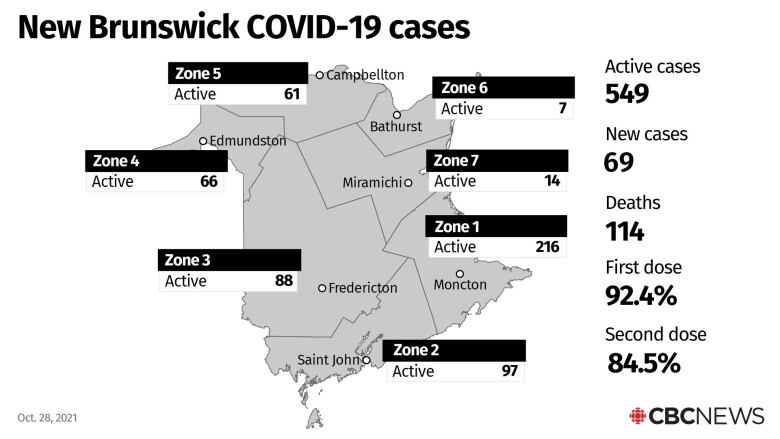
Here is the regional breakdown:
Moncton region, Zone 1,23 cases:
- Seven people 19 orunder
- Two people 20 to 29
- Three people 30 to 39
- Three people 50 to 59
- Three people 60 to 69
- A person 70 to 79
- Four people 80 to 89
Eighteen of these cases are under investigation and five cases are related to travel.
Saint John region, Zone 2, 26 cases:
- 10 people 19 or under
- Six people 20 to 29
- Three people 30 to 39
- Four people 40 to 49
- A person 50 to 59
- Two people 60 to 69
Twenty-four of these cases are under investigation, one case is a contact of a previously confirmed case and the otheris related to travel.
Fredericton region, Zone 3, seven cases:
- Two people 19 orunder
- A person 20 to 29
- Two people 40 to 49
- A person 60 to 69
- A person 70 to 79
Six of these cases are under investigation and the other is related to travel.
Edmundston region, Zone 4, five cases:
- A person 19 orunder
- Two people 40 to 49
- A person 60 to 69
- A person 70 to 79
All five cases are under investigation.
Campbellton region, Zone 5, five cases:
- Three people 19 or under
- A person 40 to 49
- A person 80 to 89
Two of thesecases are under investigation, one is a contact of a previously confirmed case and two cases are related to travel.
Bathurst region, Zone 6, two cases:
- A person 20 to 29
- A person 60 to 69
One case is under investigation and the other is related to travel.
Miramichi region, Zone 7, one case:
- A person 40 to 49
This case is under investigation.
New Brunswick has had6,332 confirmed cases of COVID-19 since the beginning of the pandemic, with 5,668 recoveries so far.
A total of524,097 lab tests had been conducted to date.
On Wednesday, 6,482 rapid test kits were distributed.
Booster doses
Beginning the week of Nov.1, people aged 65 orolder and school personnel will be able to book an appointment to receive an mRNA COVID-19 booster dose, if six months have passed since their second dose of avaccine, Dr. Jennifer Russell, the chief medical officer of health, announced Thursday.
New Brunswickerswhoreceived one or two doses of the AstraZeneca vaccine will also be able to book an appointment to receive an mRNAbooster if28 days have passed since their second dose, she said.
Booster shots will be provided the general public at a later date, Russell said.
"Based on the evidence of vaccine effectiveness, to date, we believe that most vaccinated New Brunswickers are still fully protected by the vaccine as less than six months have passed since they were fully vaccinated," she said.
"But Public Health is aware that boosters will eventually be required, and we will have a plan in place to make this happen.
Vaccine for children 5 to 11
The province is making plans for the immunization of children aged five to 11, according to the chief medical officer of health.
Health Canada is currently reviewing data from Pfizer-BioNTech, which submitted an approval request for its pediatric COVID-19 vaccine for children aged five to 11 this month.
"When Health Canada approves a vaccine for this group, we will be ready to immunize the 54,000 children in this age group as soon as we have approval from the federal authorities so that our children can be effectively protected against the virus in the months ahead," said Dr. Jennifer Russell.
A recent Angus ReidInstitute survey of Canadian parents with children in this age group found 51 per cent plan to immediately vaccinate their childrenwhen a pediatric dose becomes available, while 23 per cent said they would never give their childrena COVID-19 vaccine and 18 per cent said they would eventually vaccinate but "wait a while."
In the Atlantic region, 50 per cent of respondents said they would get their childrenvaccinatedright away, while 15 per cent said they would not vaccinate their children and 25 per cent said they would wait.
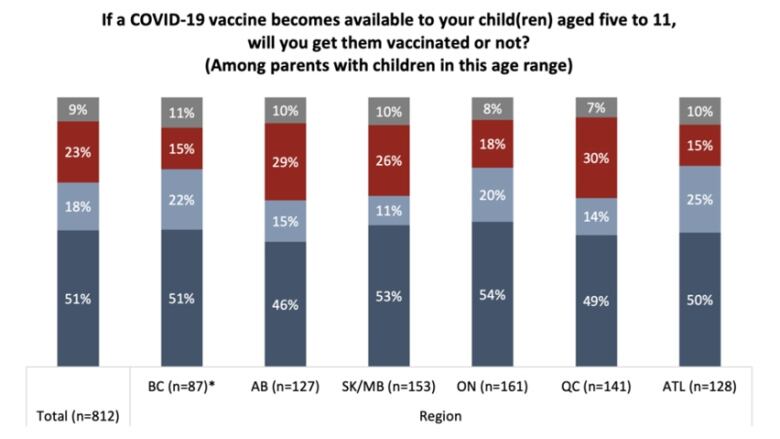
Asked how the provinceplans to address vaccine hesitancy among New Brunswick parents, Russell said a lot of thought is going into the rollout and the communications team has already delivered a presentation.
"We do know that parents have a lot of questions that they need answered. So part of our plan is going to be making sure that we have a rollout that involves having factual information available to all parents," she said.
"And a lot of that engagement will happen, perhaps in local communities and areas with local representatives and local health-care providers helping us amplify those messages at the local level."
The online survey, which was commissioned and paid for by the Angus ReidInstitute, was conducted from Sept. 29 to Oct. 3,among 5,011 Canadian adults who are members of the AngusReid Forum. Aprobability sample of this size would carry a margin of error of +/- 2.0 percentage points, 19 times out of 20, according to Angus Reid.
There were 812 respondents with children aged five to 11, including 128 in the Atlantic provinces.
Johnson & Johnson vaccines coming
New Brunswick will be receiving about500 doses ofJohnson & Johnson's one-dose COVID-19 vaccine Janssen, said the chief medical officer of health.
Asked who they will be used for, Russell replied, "We are putting a plan together at this moment and we can provide more details on that as we get them."
She did not say when the vaccines are expected to arrive.
Nor did she say how many doses the province requested.

Alberta, Saskatchewan and British Columbia have requested tens of thousands of doses of the vaccine as a way to try to increase vaccine uptake. Alberta Premier Jason Kenney has said some people in areas of low vaccine uptake have expressed a preference for the Janssen vaccine and thinks the new option might sway some holdouts.
Earlier this month, the Department of Health told CBC News the province had "submitted an expression of interest to the federal government to secure a small quantity."
"Procurement is still underway, and amounts have not yet been determined,"spokesperson Gail Harding had said in an emailed statement.
Changes to school rapid-test rules
Unvaccinated students who are required to take rapid tests at home because they have been identified as close contacts of aconfirmed COVID-19 case in schools will no longer be requiredto bring their negative resultsto school every day, Premier Blaine Higgs announced Thursday.
The province wants toprevent the stigmatization of children at schools, he said.
"However, we will also need to have absolute confidence that the tests are being performed at home."
So the mandatory order has been updated to include a provision that makes it a finable offence to falsify or deliberately misrepresent the results of a point-of-care test (POCT), Higgs said.
A child can return to school aftertwo negative rapid-test results, he said.
If the results are positive, it's the parent's responsibility to ensure a follow-up polymerase chain reaction (PCR) lab test is booked immediately to confirm the results and thechild must isolate until they receive a negative PCR test result.
Confirmed cases don't always close schools
Five cases of COVID-19 have been confirmed at five schools, the COVID-19 dashboard shows.
In the Saint John region, Zone 2, apositive case has been detected at St. John the Baptist/King Edward School, which was not previously impacted,Simonds High School,Loch Lomond SchoolandPolyvalente Thomas-Albert.A case has also been confirmed atDalhousie Regional High School in the Campbellton region, Zone 5.
Thirty-six schools are currently impacted.
St. John the Baptist/King Edward School andSimonds High School both had an operational day Friday,with students learning from home,according to a notice issued by the Anglophone South School District.
Dalhousie Regional High School also had an operational day, the Department of Education's website shows.
Schools no longer always close to students when there's a confirmed case, a department spokesperson confirmed.
"As per the most recent updates to the Healthy and Safe Schools guidelines, schools may move to home learning following a confirmed case that impacts students,"FlavioNienow said in an emailed statement.
He pointed to the new rapid-testing program in schools. The aim of the program is to minimize the impact on learning, allowing studentsto return to school, provided they have no symptoms, have received two negative rapid tests and continue to rapid test daily for the remainder of the exposure period, as outlined by Public Health, he said.
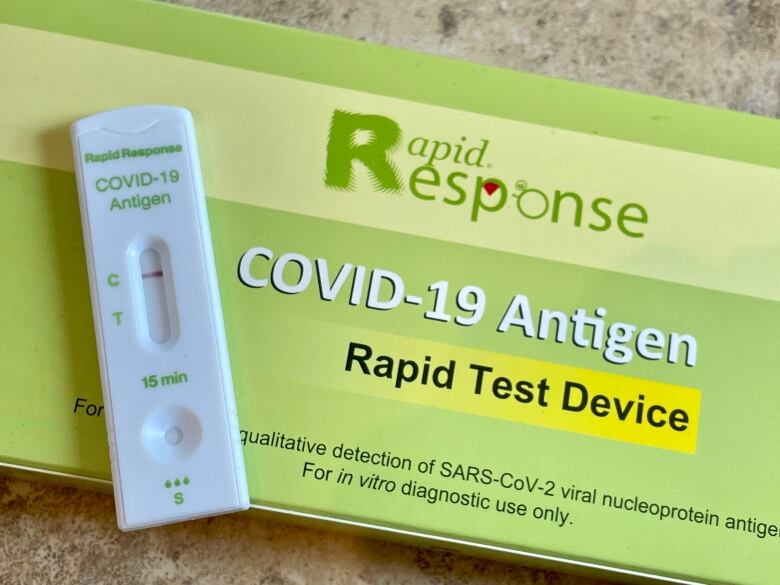
"When a school experiences an outbreak, Public Health "carries out a detailed risk assessment and gives direction to students and school personnel based on factors within the circumstances of each individual situation, including any requirements for additional cleaning and disinfection of areas," Nienow said.
"This is why two schools may respond to confirmed cases differently."
While cleaning and disinfecting areimportant mitigating factors, they are just one component of a layered approach to protecting students and staff, he added.
Others includevaccination, masking, physical distancing, hand washing, "respiratory etiquette," suitable ventilation, staying home when sick and getting tested when symptomatic.
A total of 401 cases of COVID-19 had been confirmed at 110schools since the beginning of the school year.
Fifty-nine early learning and child-care facilities have had confirmed cases of COVID-19 since Sept. 7. The total number of cases has not been provided.
Public exposure notices
Public Health added several new public exposure notices Thursday, including Casino New Brunswick in the Moncton region, Zone 1, a beauty salon and construction sitein theSaint Johnregion, Zone 2, both over three days, and a hotel and conference centre in the Edmundston region, Zone 4.
For the full list of new and previous public exposure notices, please visit thegovernment of New Brunswick's website.
Public Health recommends that people who have not been fully vaccinated at least 14 days prior to a possible exposure get a COVID test, even if they don't have symptoms. They can book an appointmentonlineor call Tele-Care 811.
If they do have symptoms, they must isolate while they await their results.
It can take up to 14 days to test positive after being exposed to COVID-19 so even if their results comes back negative, they should continue to self-monitorfor any symptoms and get tested immediately if any develop.
They should also avoid visiting settings with vulnerable populations, such as nursing homes, correctional facilities and shelters during that 14-day period.
For people who have beenfully vaccinated at least 14 days prior to a possible exposure, Public Health recommends they monitor for symptoms for 14 days after the possible exposure and get a COVID test if symptoms develop.
They do not need to isolate while they waitfor their test results.
What to do if you have a symptom
People concerned they might have COVID-19 cantake a self-assessment test online.
Public Health says symptoms of the illness have included a fever above 38 C, a new or worsening cough, sore throat, runny nose, headache, a new onset of fatigue, and difficulty breathing.
In children, symptoms have also included purple markings on the fingers and toes.
People with one of those symptoms should stay at home, call 811 or their doctor and follow instructions.













_(720p).jpg)


 OFFICIAL HD MUSIC VIDEO.jpg)
.jpg)



























































































